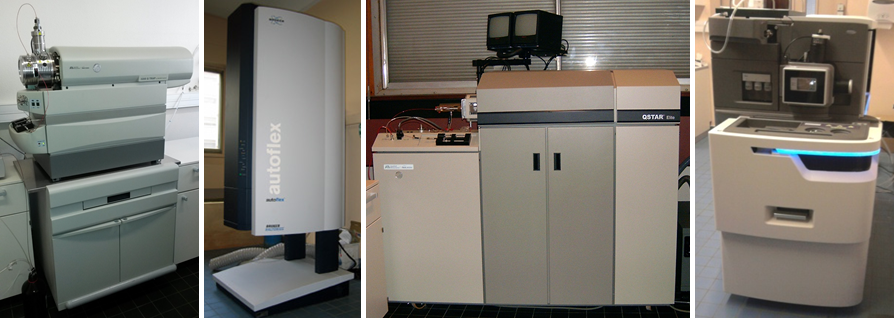Mass spectrometry
Mass Spectrometry service offers a complete panel of analytical services:
Low Resolution Analysis
- Confirmation/determination of the molecular weight of non-volatile organic compounds (MS)
- Structural characterization of non-volatile organic compounds (MS/MS)
- Synthetic polymers characterization (mass of repeating unit, molecular weight of the sum of the end- groups, distribution parameters Mn, Mw, Đ
High Resolution Analysis (accurate mass measurements)
- Confirmation/determination of elementary composition of non-volatile organic compounds (MS)
- Structural characterization of non-volatile organic compounds (MS/MS)
- Confirmation/determination of the elemental composition of the sum of the end-groups of synthetic polymers
Our Means
Organic compounds
These analyses are performed on the 3200 Q-TRAP mass spectrometer (AB Sciex). The spectrometer is equipped with ionization sources at atmospheric pressure (ESI, APCI) and it is reserved for the analysis of non-volatile molecules in solution, dissolved in a solvent.
The 3200 Q-TRAP mass spectrometer possesses two tandem analysers: a quadrupole (Q) and a linear ion trap (TRAP).
This configuration allows multiple modes of operation (MS, MS/MS, MS3) in quadrupole or ion trap mode and is particularly suitable for the structural study of organic compounds.
The collisions that induce ion fragmentation can be produced (i) in the collision cell (MS/MS), (ii) in the collision cell and in the ion trap (MS3).
The energy applied to the ions varies according to the collision mode used and the comparison of the results obtained with the two systems increase the accuracy of the structural hypothesis.
Low resolution Mass Spectrometer 3200 Q-Trap (AB Sciex)
Synthetic polymers
These analyses are performed on the Autoflex I (Bruker) mass spectrometer equipped with a MALDI source.
MALDI (Matrix Assisted Laser Desorption Ionization) ionization technique is ideally for the analysis of the compounds with a molecular weight greater than 1000 Da that are not suitable for electrospray ionization.
The principle of MALDI ionization is based on the desorption of characteristic ions formed by a ternary mixture of analyte, matrix and salt upon irradiation with a laser beam.
The analyzer coupled to the MALDI source is a time-of-flight (TOF) whose range of analysis is, from theoretical point of view, unlimited. This analyser can be used in two operating modes: linear or reflectron mode.
The linear mode allows the analysis of very high mass macromolecules but without isotopic resolution.
The reflectron mode can only be used for compounds with a molecular weight below 20 kDa and generally, allows isotopic resolution.
Low Resolution Mass Spectrometer Autoflex I (Bruker)
High Resolution Measurements: Organic compounds and synthetic polymers
This kind of analyses are carried out on mass spectrometers.
Q-STAR Elite (AB Sciex) and/or SYNAPT G2 HDMS (Waters).
Equipped with an electrospray ionization source (ESI), they are reserved for the analysis of non-volatile molecules in solution, dissolved in a solvent.
These mass spectrometers are equipped with a time-of-flight (TOF) analyser operating in reflecton mode.
The orthogonal injection of the ions into the tube of flight allows high-resolution analyses and consequently the determination of the elemental composition of the ions.
In addition, their tandem geometry (QqToF), which couples a quadrupole to the time-of-flight analyser, allows accurate measurement of fragment ion elemental composition.
The use of the MALDI source on the SYNAPT G2HDMS mass spectrometer (Waters) allows accurate mass measurements of ionized macromolecules. Thus, the elemental composition of the sum of the end-groups can be determined.
